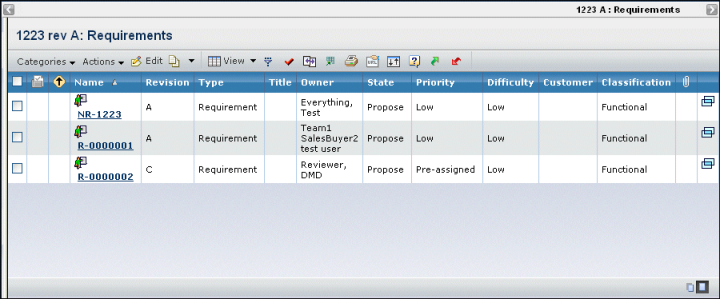Listing Requirements | ||||
|
| |||
From the global toolbar, click
 > Requirements > Requirements.
> Requirements > Requirements.
Or
-
From the global toolbar, click
 > Product Line > Products.
> Product Line > Products.
The Products page opens.
-
From Products listing, click Product name or
 .
.
The Properties page opens.
-
From the Categories menu, click Requirements.

The Requirements page column details are as follows:
Select Box. Click the column header box to select all requirements. Click the row box to select one or more requirements.
Active Engineering Change. The
 icon is present when
the object is related to an active Engineering Change (EC) that is not
in the Complete, Rejected or Closed state. For details about ECs, see Working with Engineering Changes.
icon is present when
the object is related to an active Engineering Change (EC) that is not
in the Complete, Rejected or Closed state. For details about ECs, see Working with Engineering Changes.Higher Revision. The
 icon is present when
a higher revision of the requirement exists.
icon is present when
a higher revision of the requirement exists.
Name. The name of the requirement. Click the requirement name to go to its Properties page.
Revision. The Revision of this requirement.
Type. The name that defines the type of requirement: requirement, customer requirement, or user requirement.
Title. A descriptive identifier for the requirement.
Owner. Person who is currently assigned responsibility for the requirement.
State. The current state of the requirement in its lifecycle.
Priority. How important the requirement is: low, medium or high priority.
Difficulty. How difficult the requirement would be to implement: low, medium or high.
Customer. The customer for whom the requirement would be implemented.
Classification. The user classification of the requirement: None, Functional, Non-functional, or Constraint.
 Quick file access. The paperclip icon is present if files are checked
into or connected to the object. Click the icon to open the Files page.
See the Accessing File Lists.
Quick file access. The paperclip icon is present if files are checked
into or connected to the object. Click the icon to open the Files page.
See the Accessing File Lists. Opens the Properties page in a new window. See Viewing Requirement Properties.
Opens the Properties page in a new window. See Viewing Requirement Properties.
-
From the global toolbar, click
To filter the list of requirements, select the filter from the drop-down list at the top, right.
To view more details about a requirement, click the Name of a requirement to load the Properties page into the main ENOVIA window. See Viewing Requirement Properties.
Use the Actions menu or page toolbar to work with requirements:
Create New. Create a new requirement from scratch. See Creating a New Requirement.
Copy. Click to copy the contents of the selected requirement to create a new requirement. See Copying a Requirement.
Requirement Structure Browser. Click to view the selected requirement in the Requirement Structure Browser. See Using the Requirement Structure Browser.
Structure Content Editor. Click to see this requirement as a document with structure and text content. See Structure & Content Editor.
Traceability Report. This section generates various reports showing the relationship of baseline, sub and derived requirements. Select a menu option to start the report definition. For information about the different traceability reports, see About Traceability Reports.
Raise Engineering Change. This creates an engineering change based on the requirement. See Working with Engineering Changes.
Attach to Engineering Change. This allows you to search for an existing engineering change and attach this requirement to it. See Working with Engineering Changes.
Revision. Click to create a revision of one or more selected objects. See Creating Requirement Revisions.
Subscribe. Click to select the events for which you would like to be notified for the selected requirement(s). For information about subscriptions, see Working with Subscriptions.
Delete. Removes all checked requirements from the list and deletes them from the database; select OK to confirm.
You cannot delete a requirement that includes objects reserved by another user.